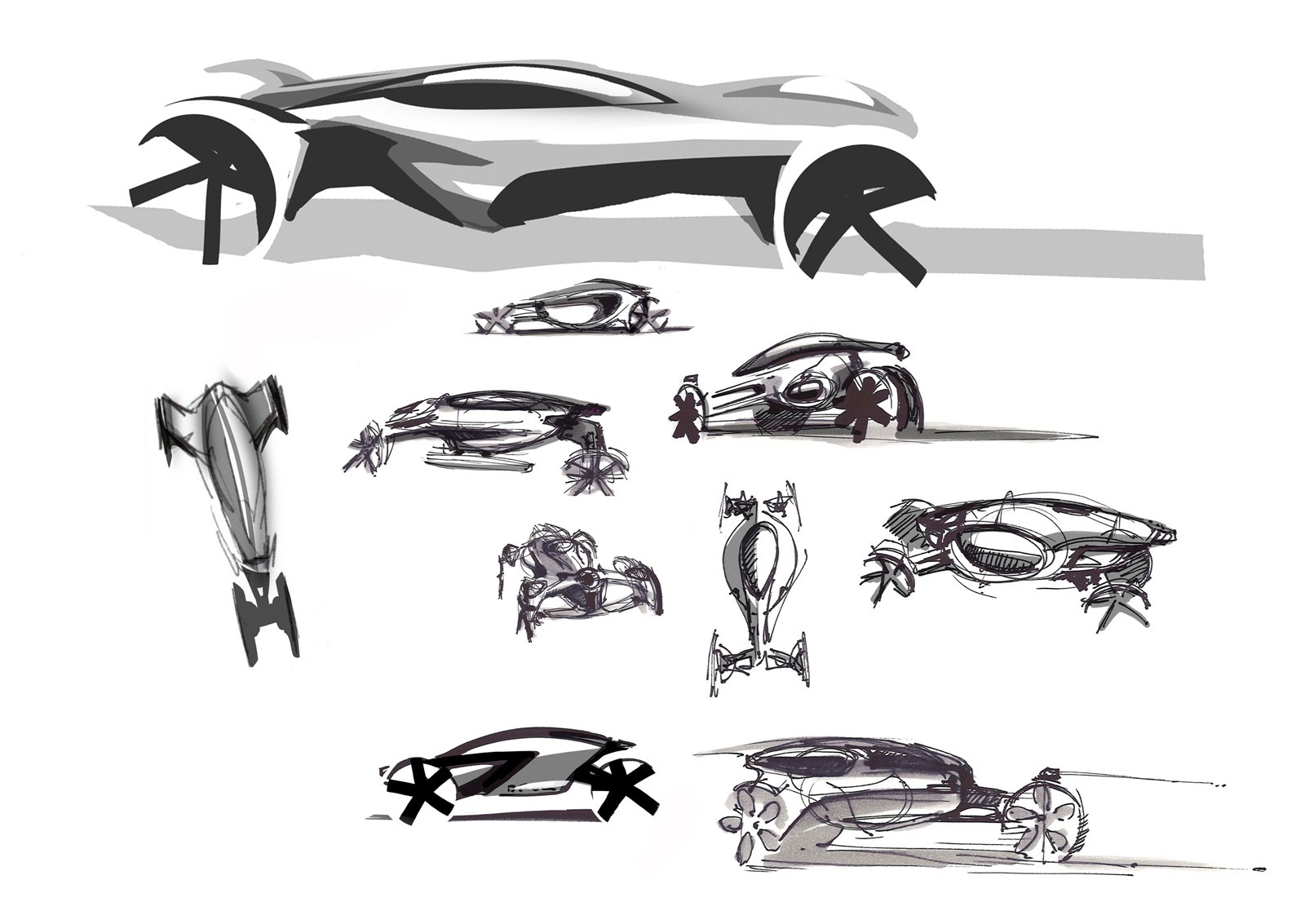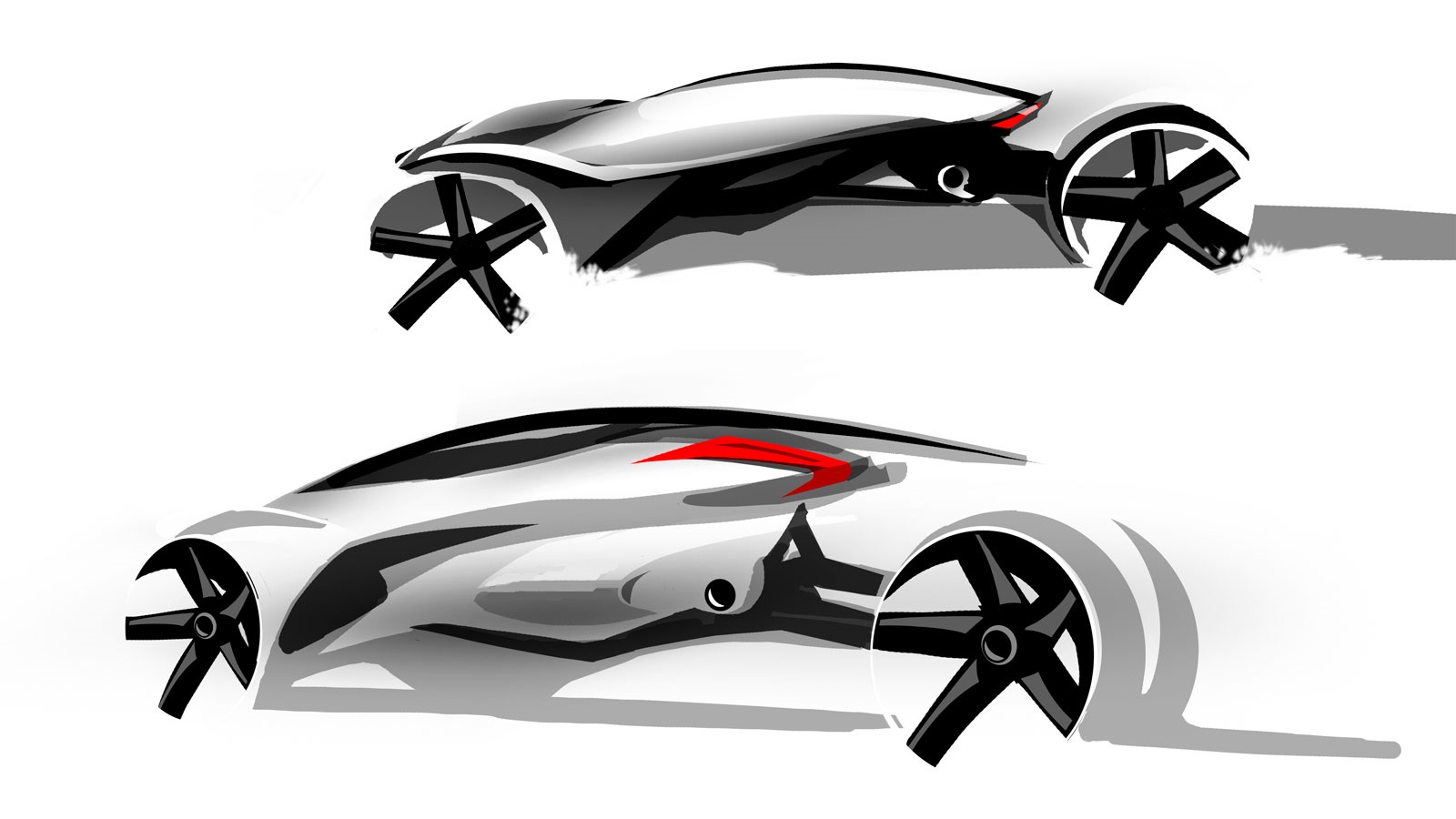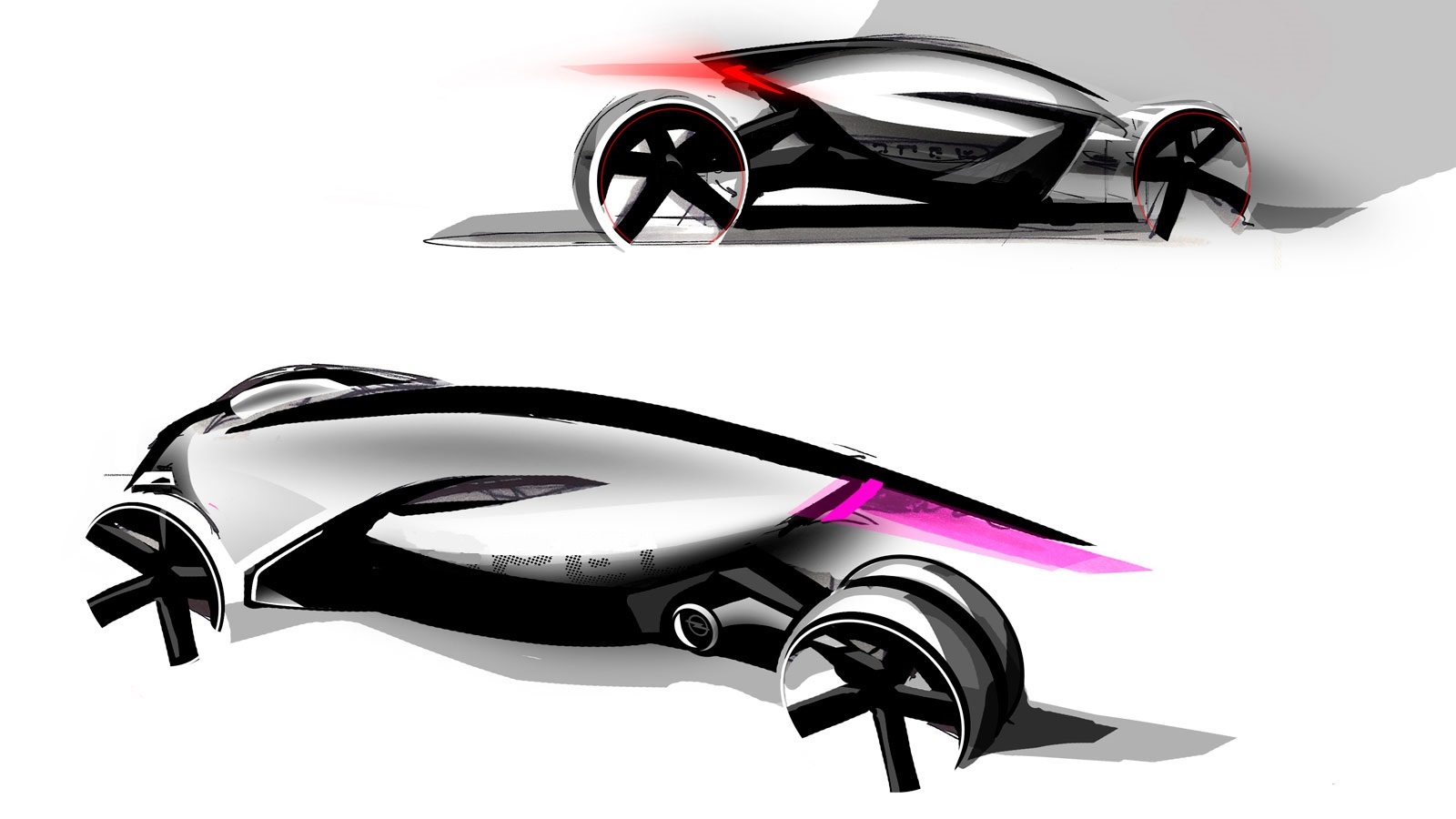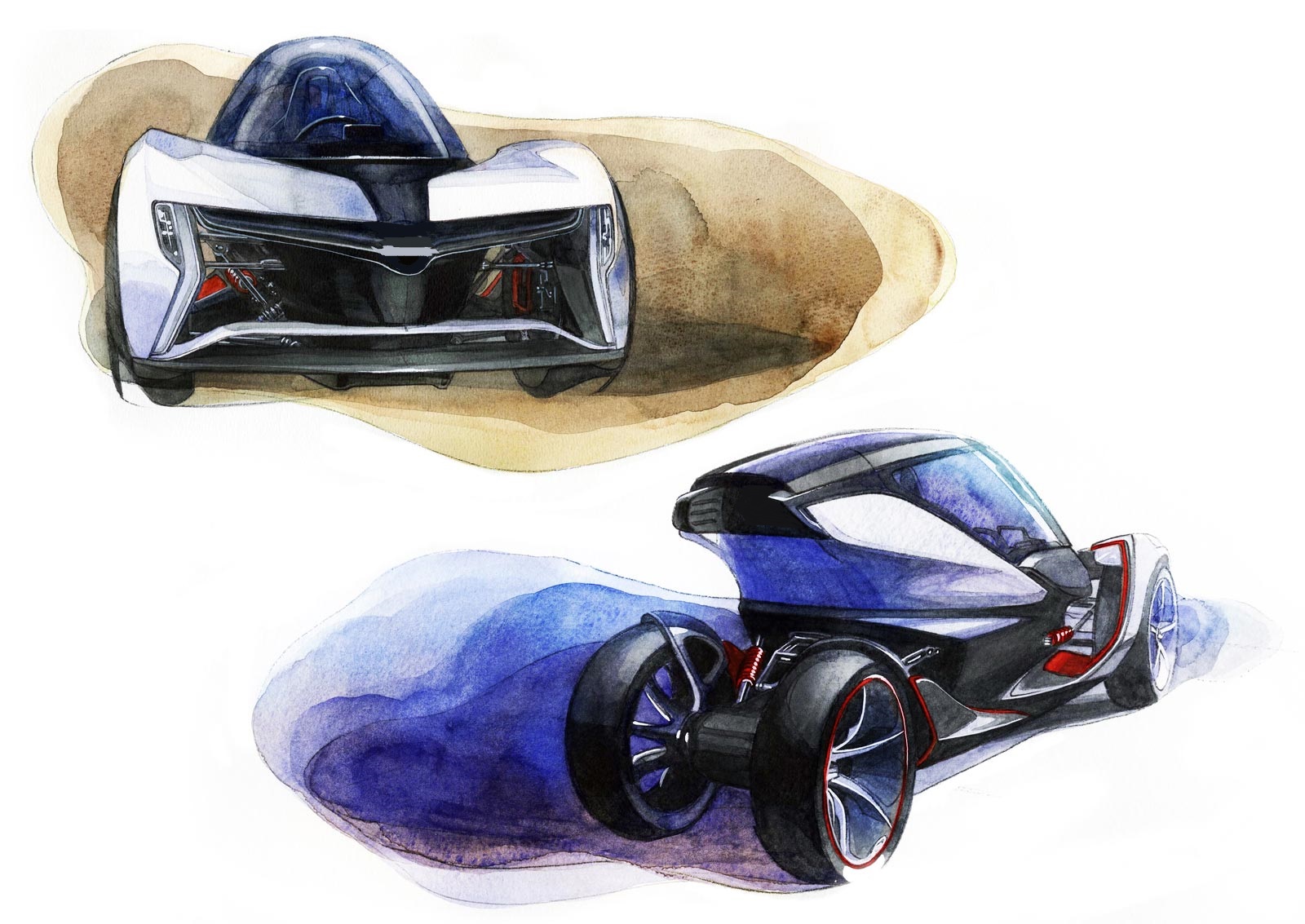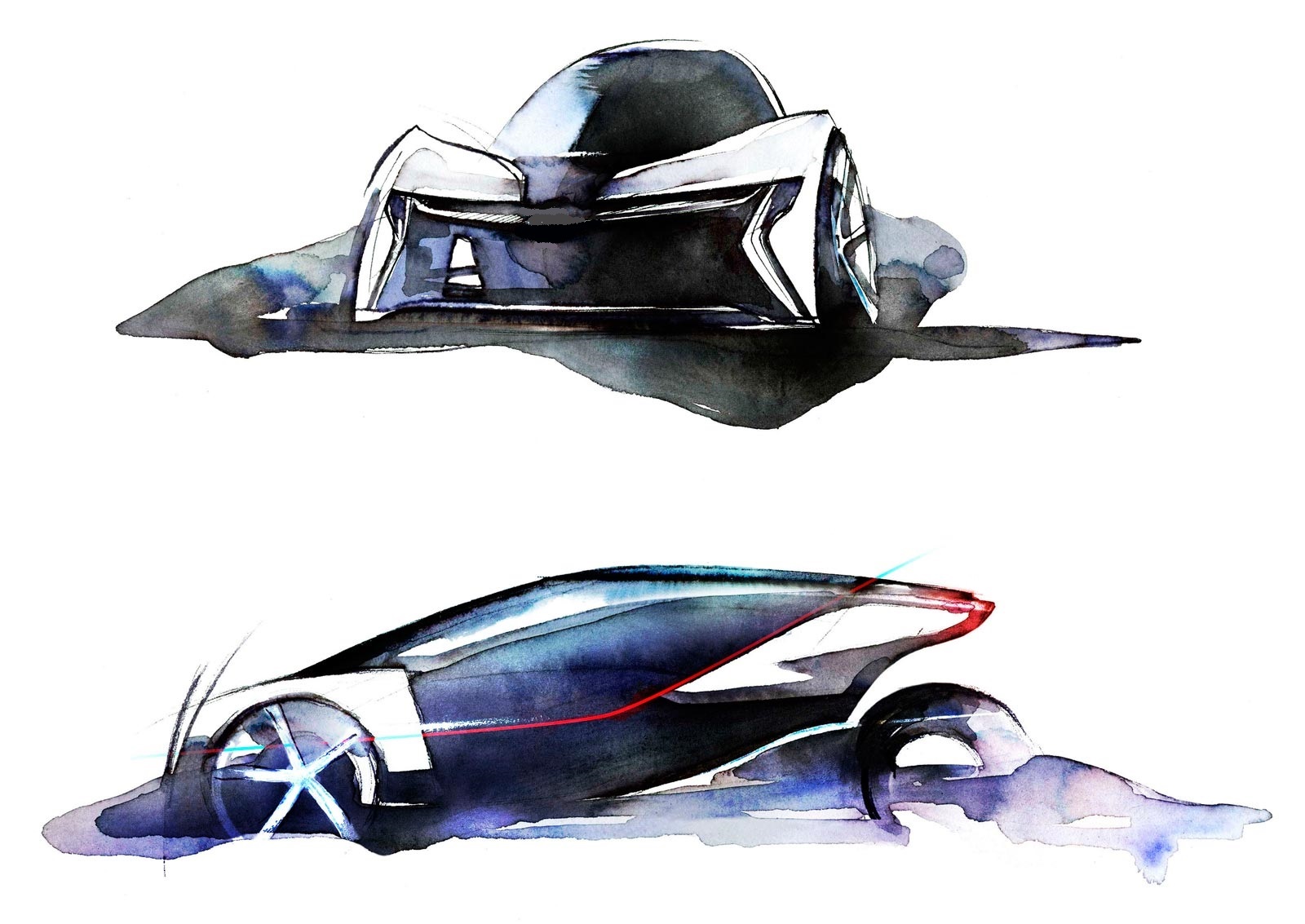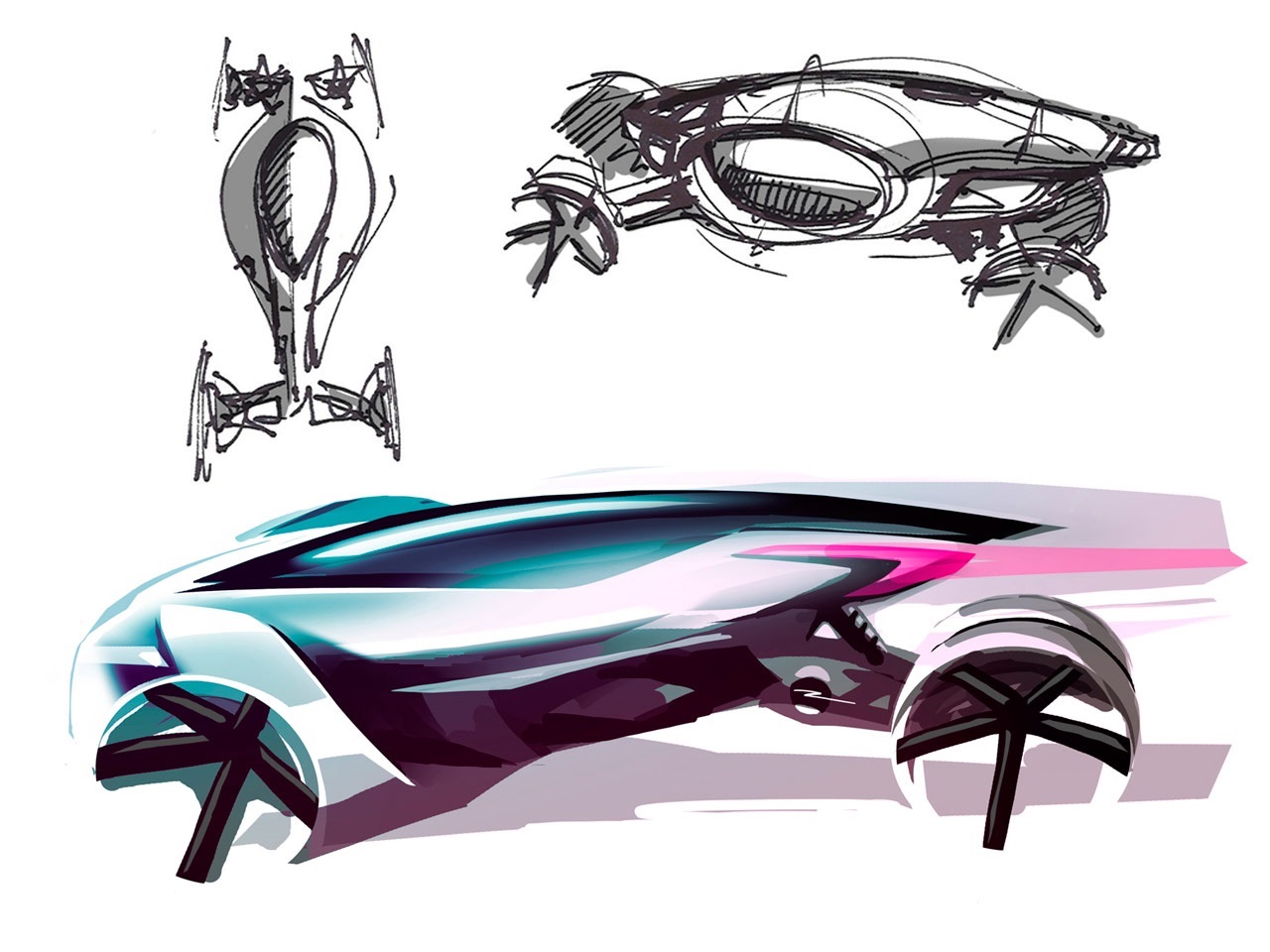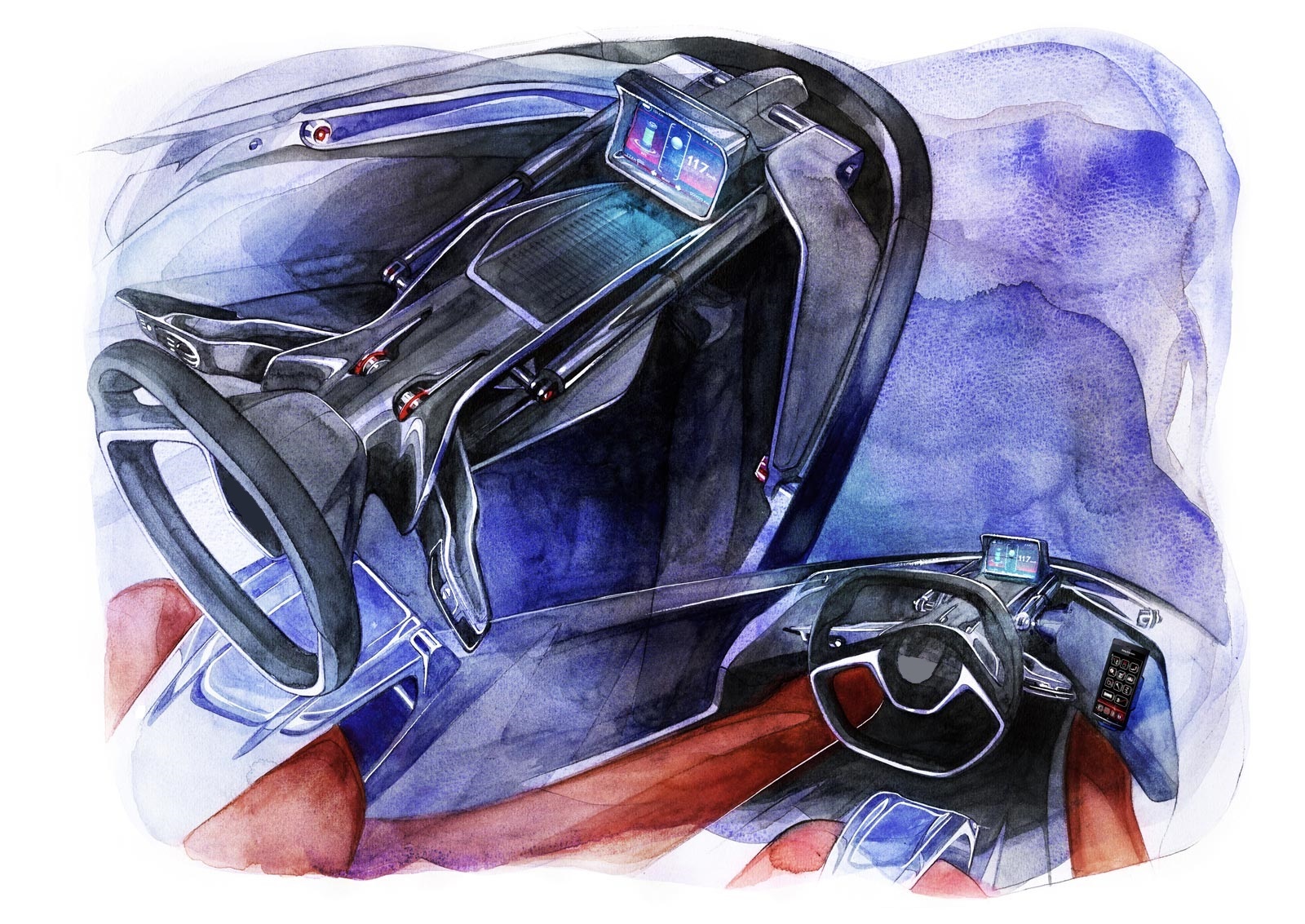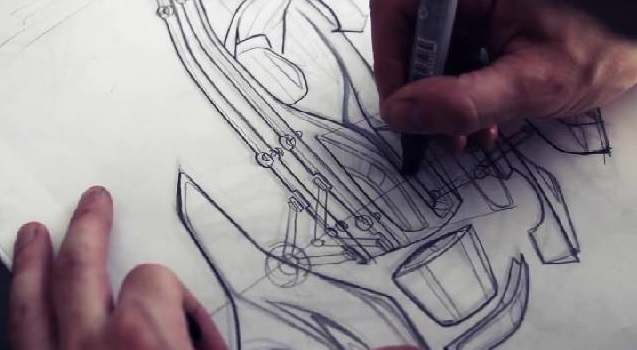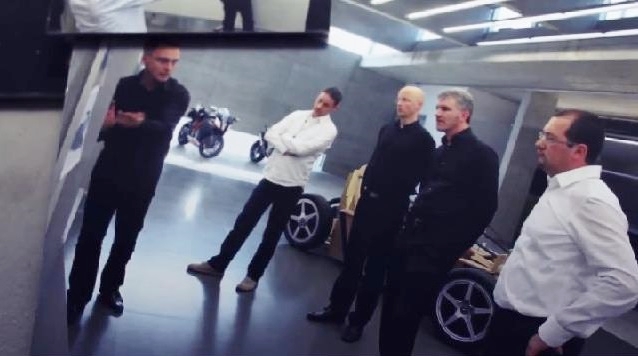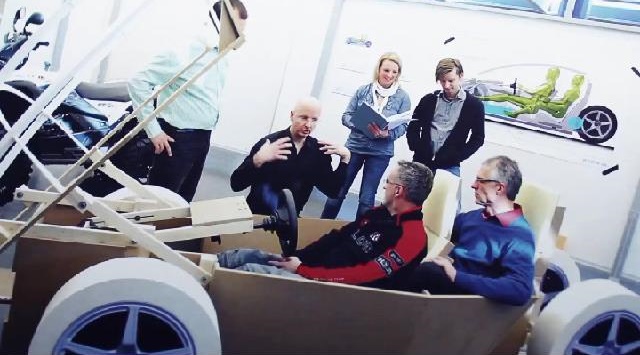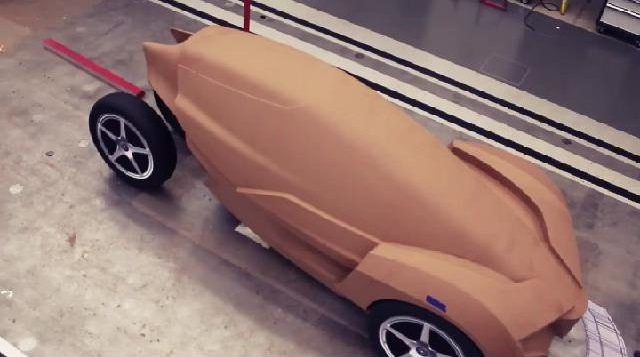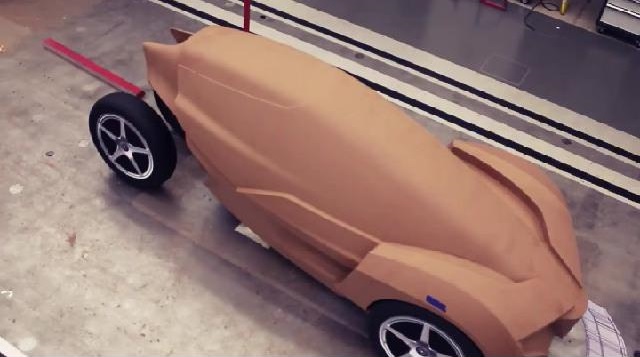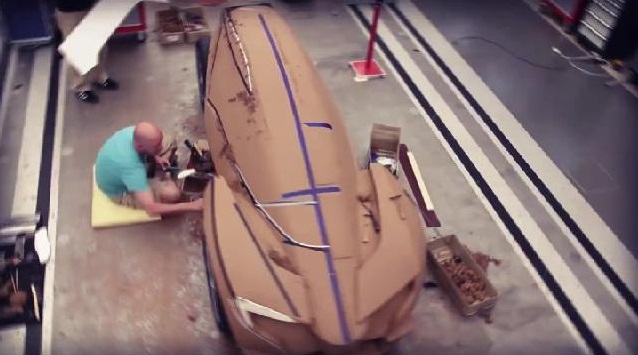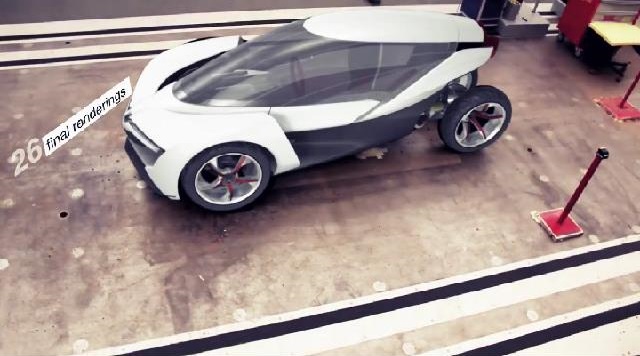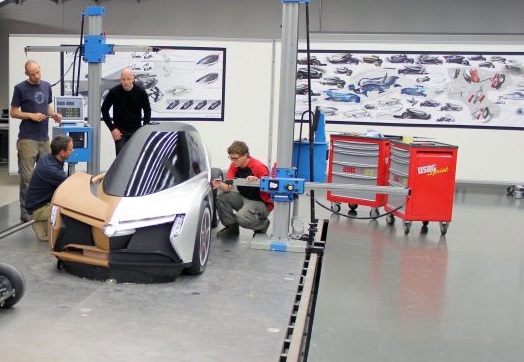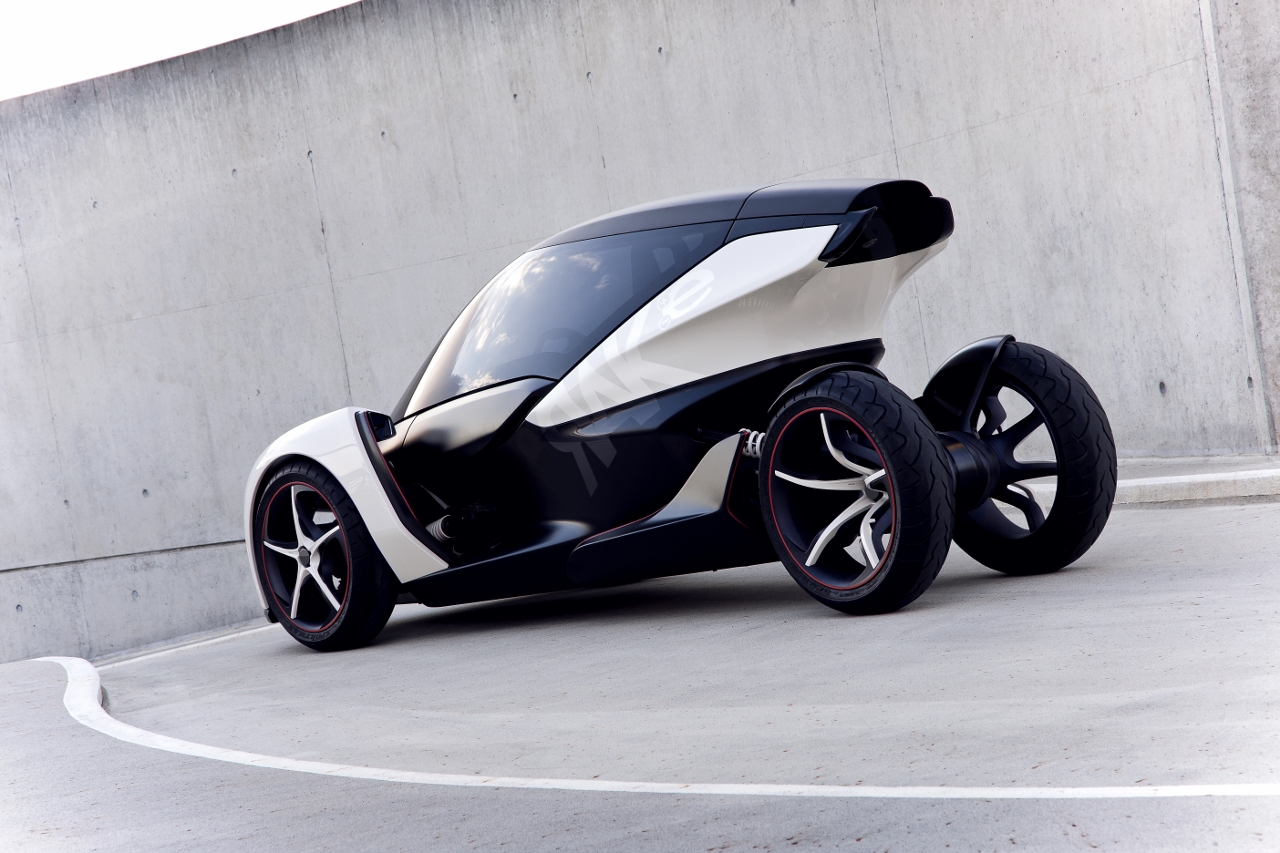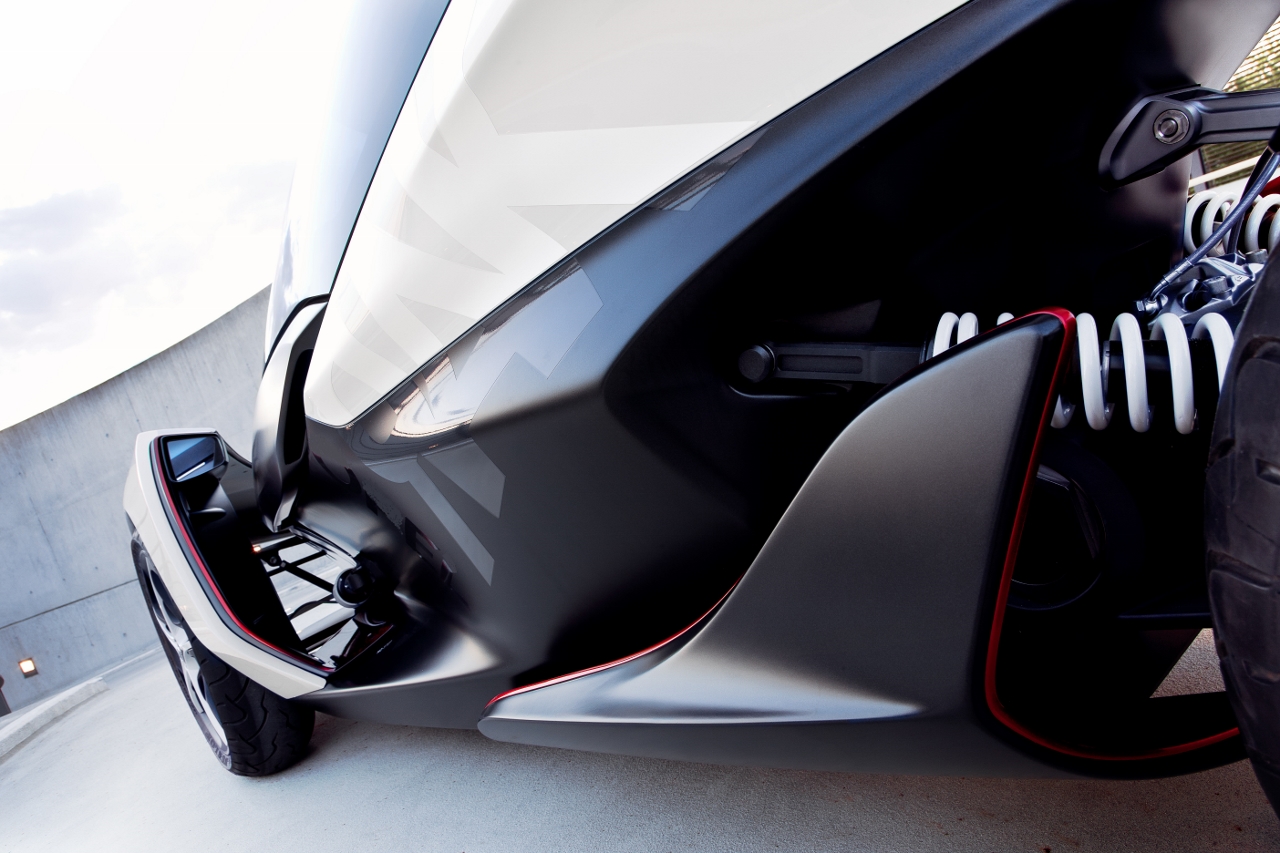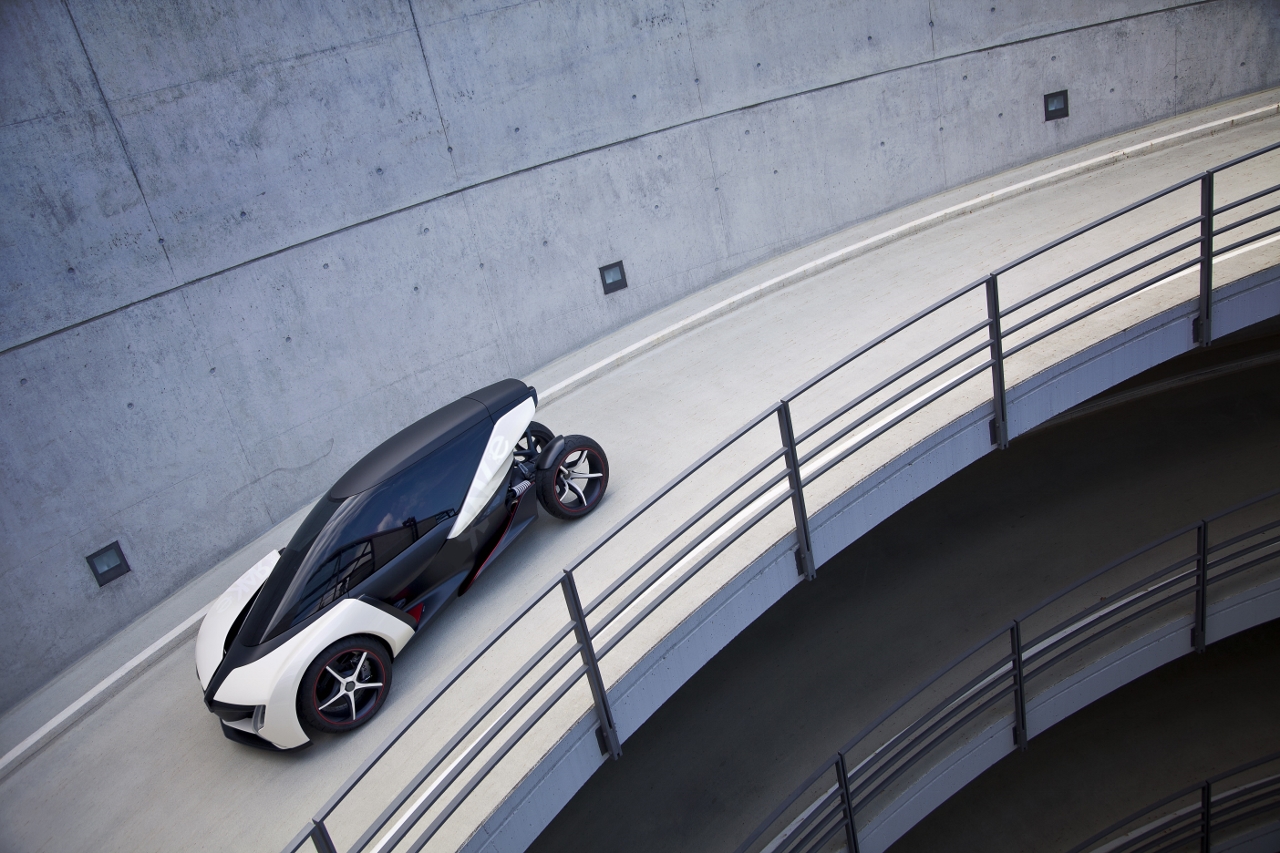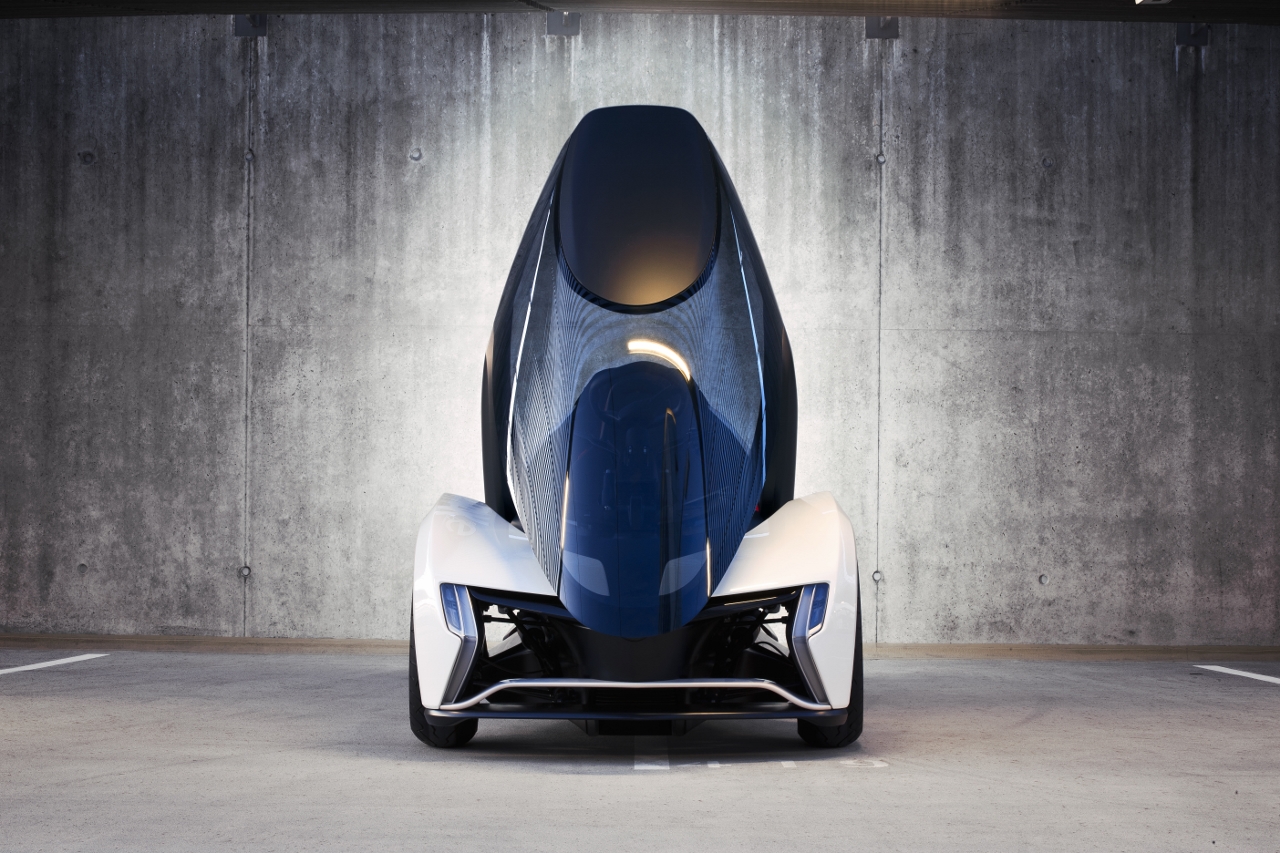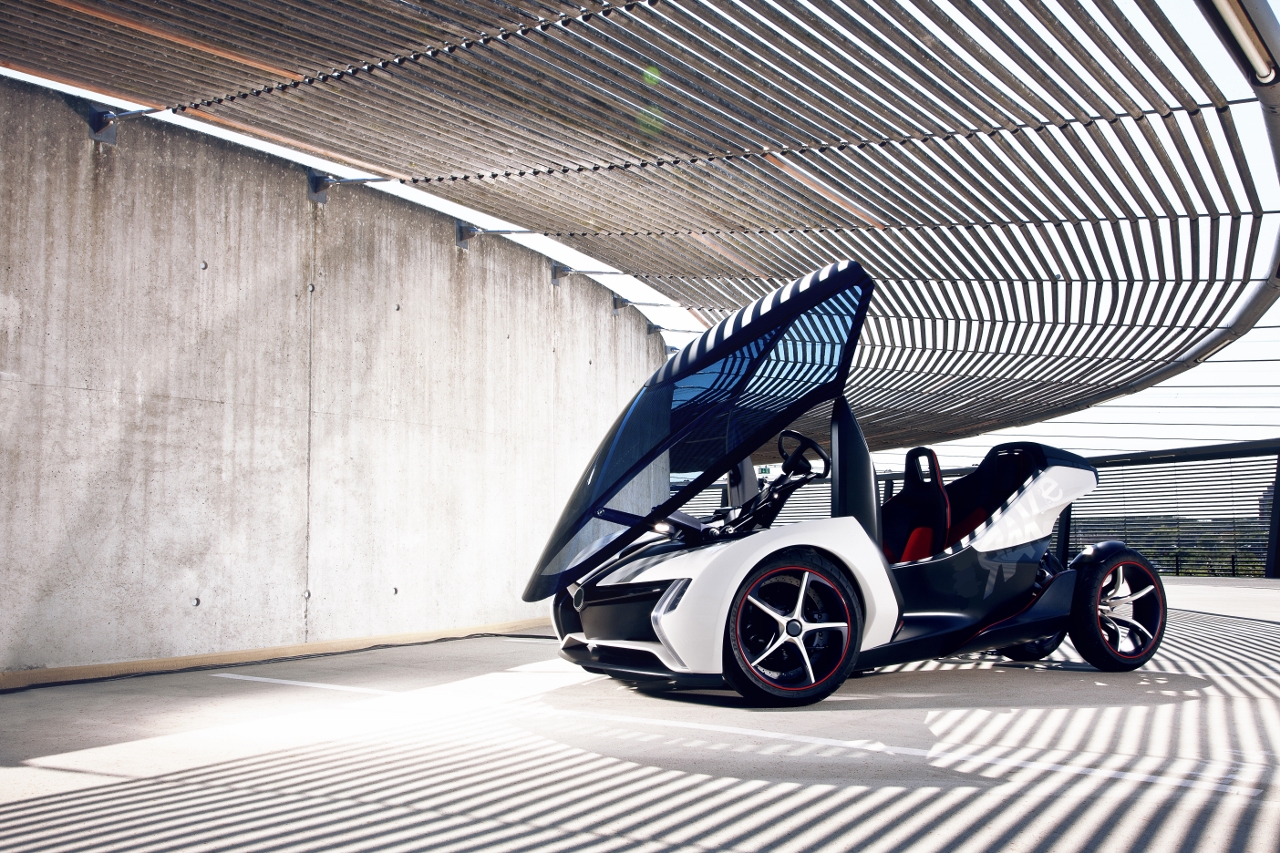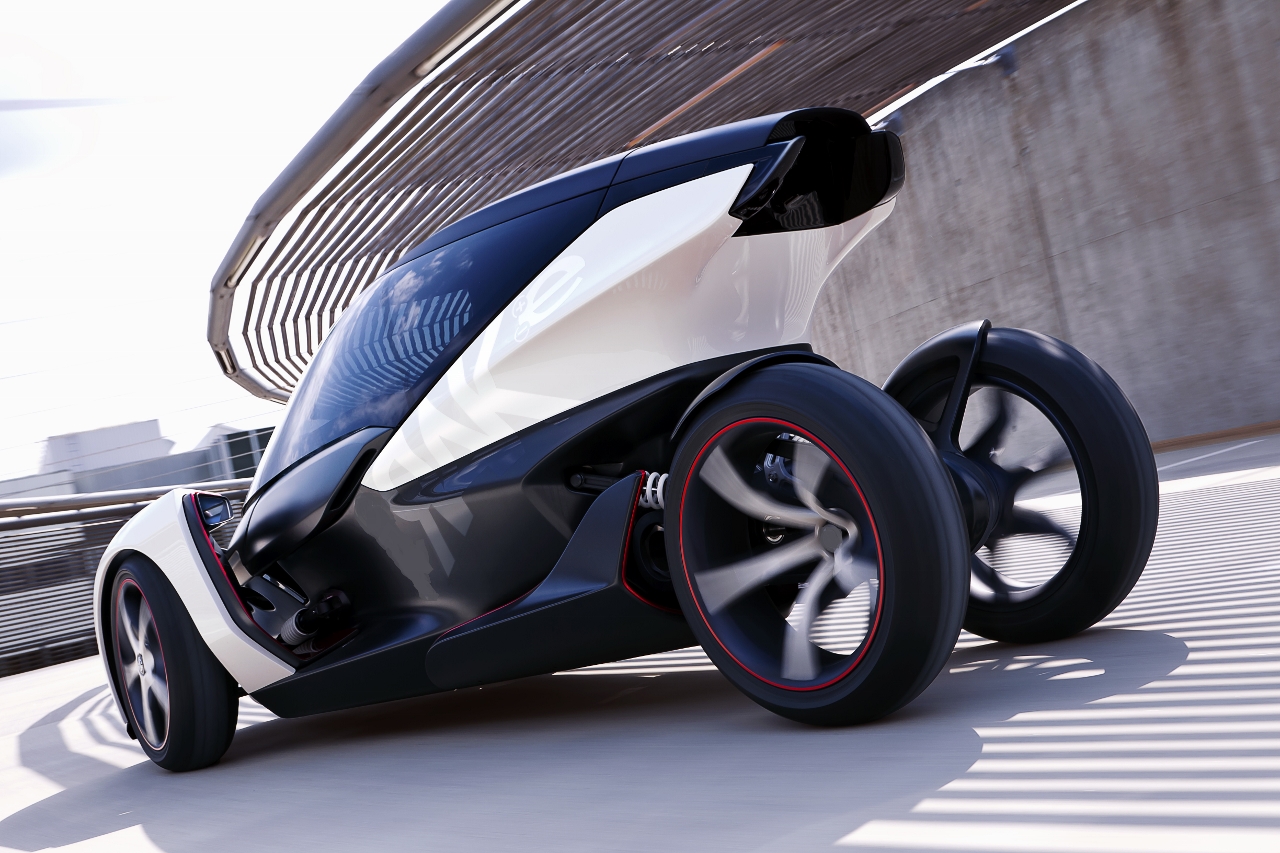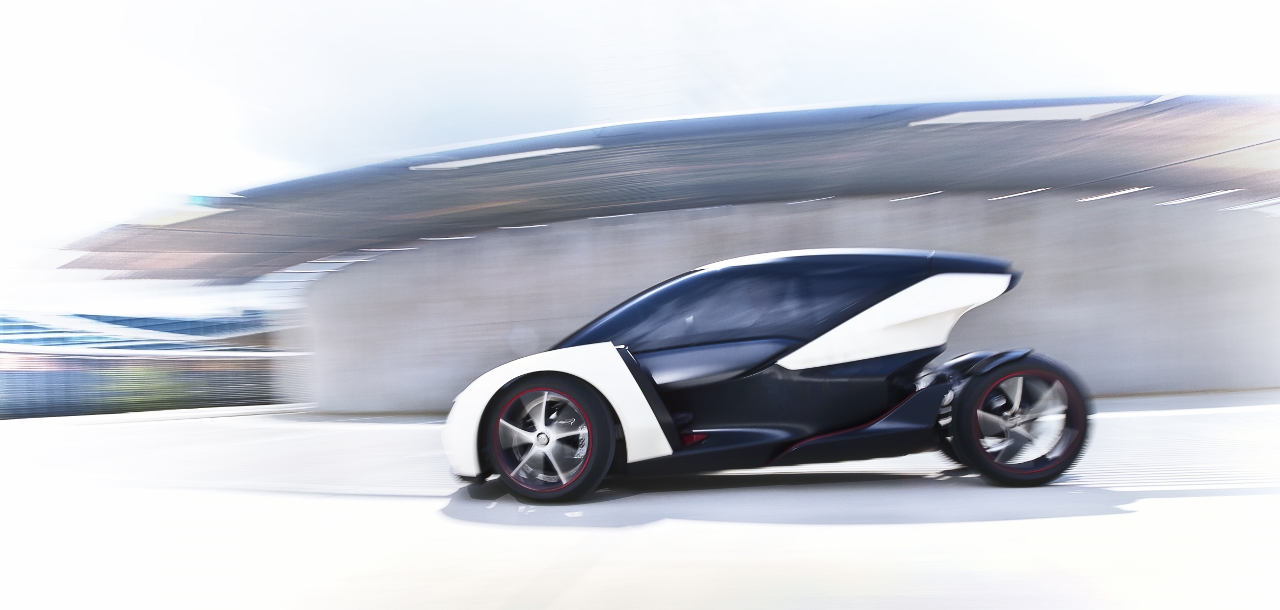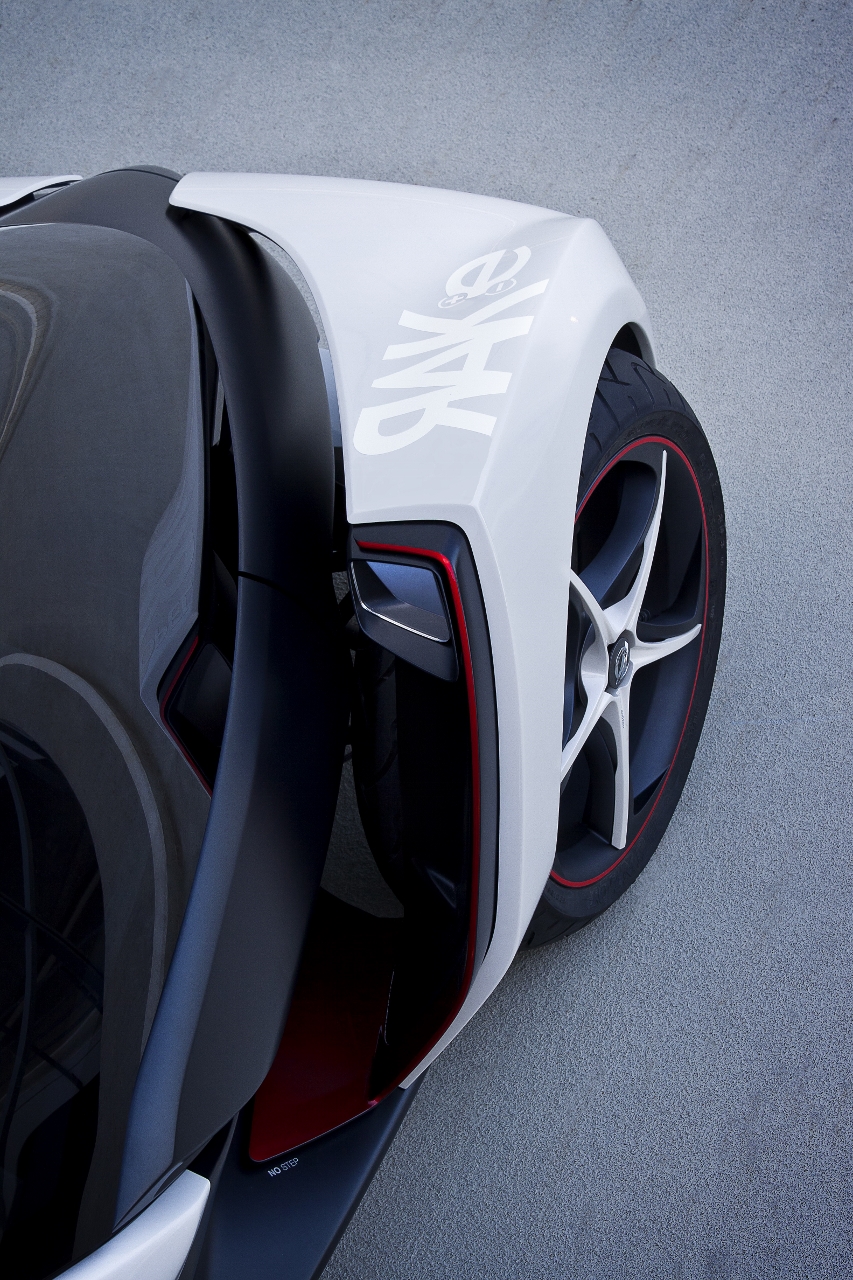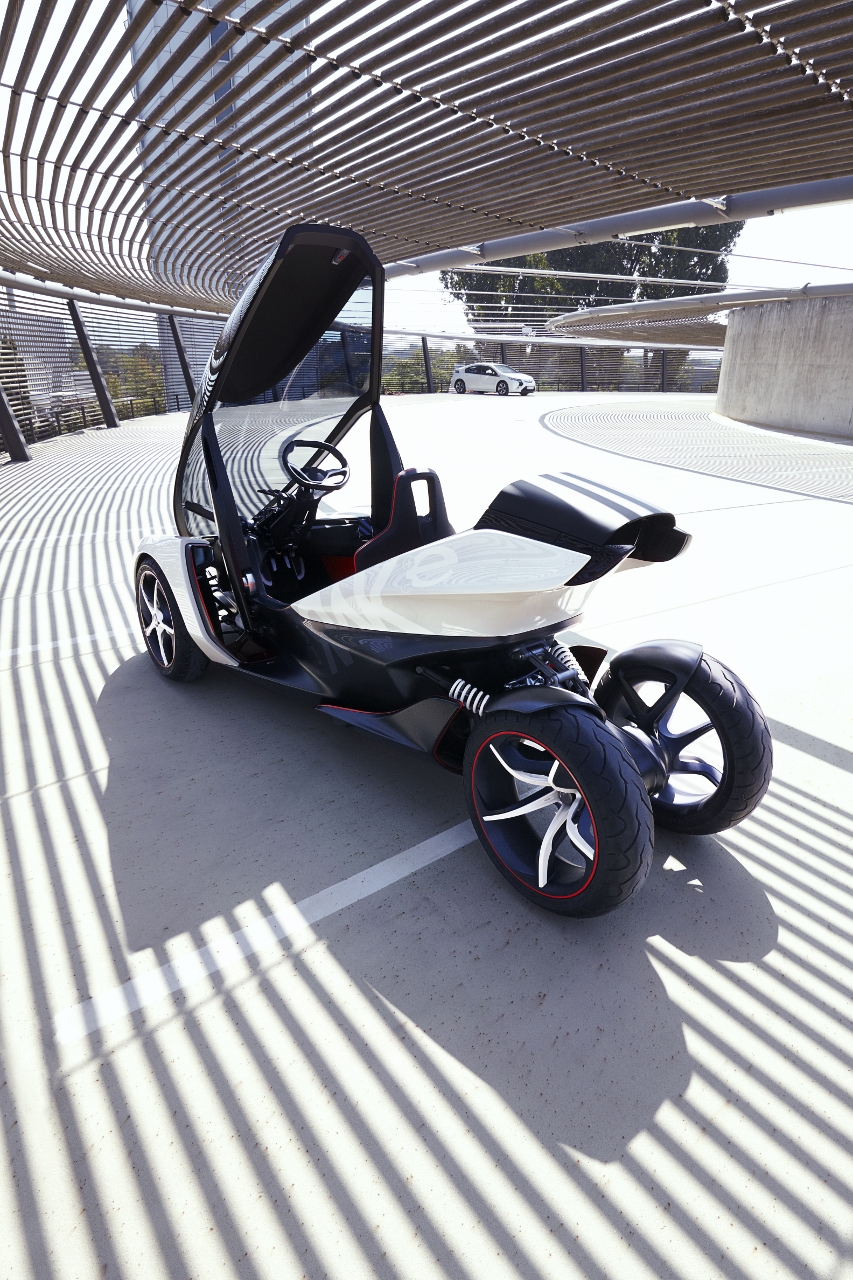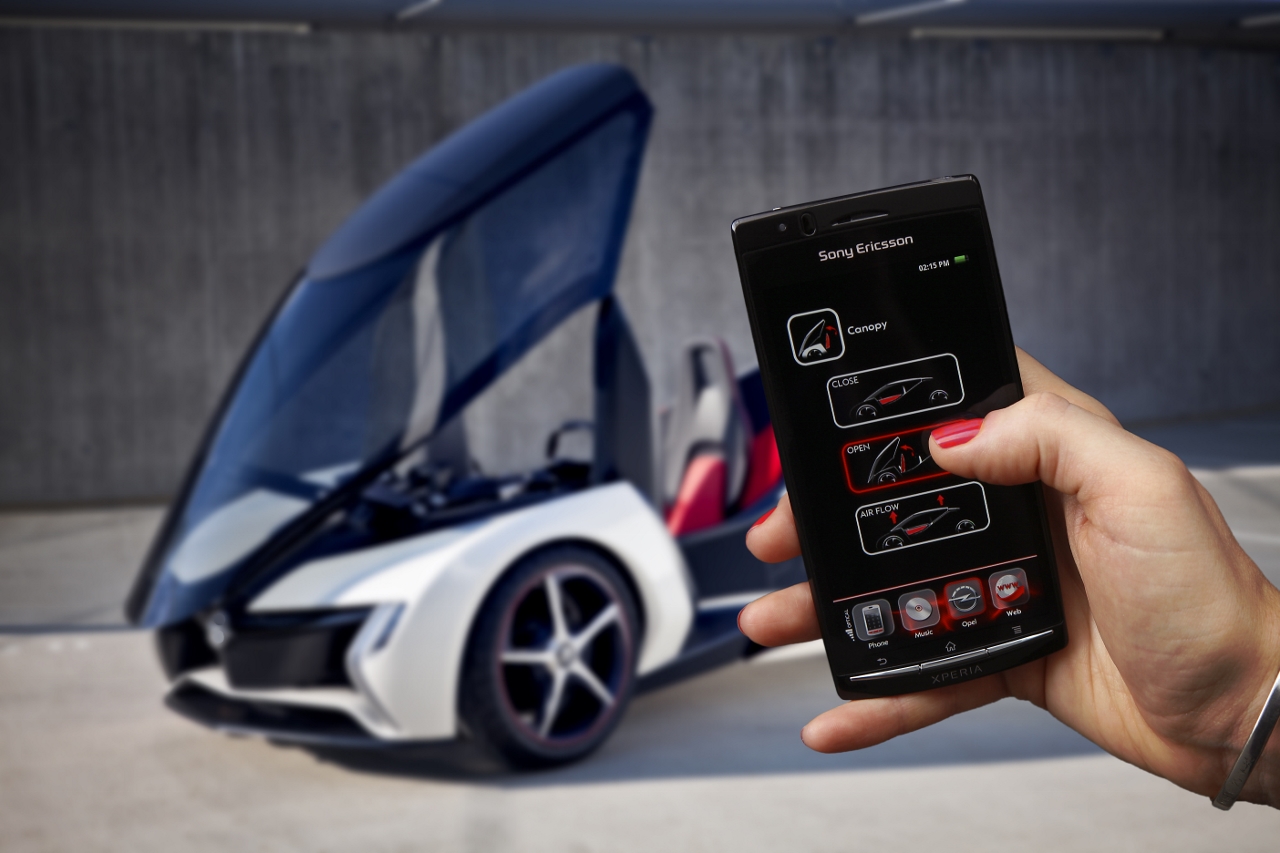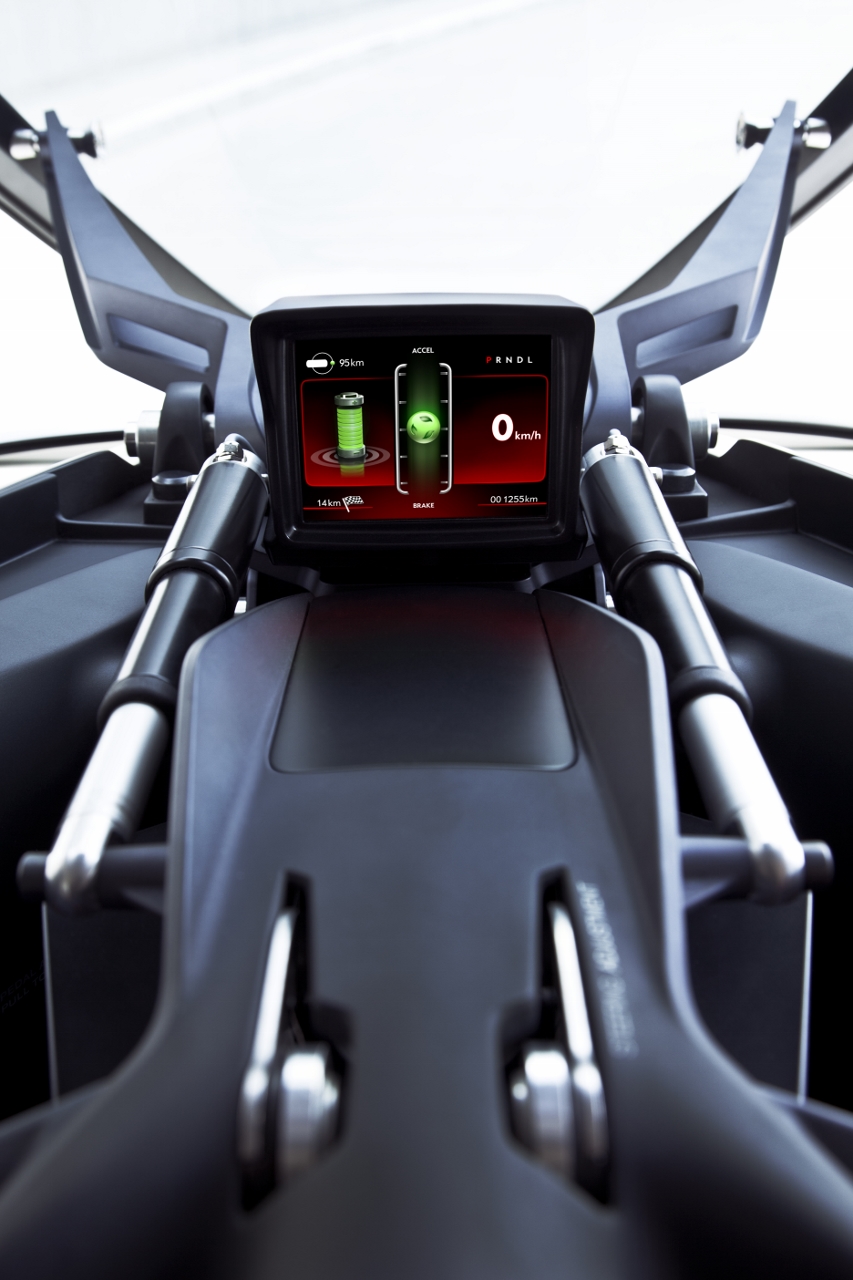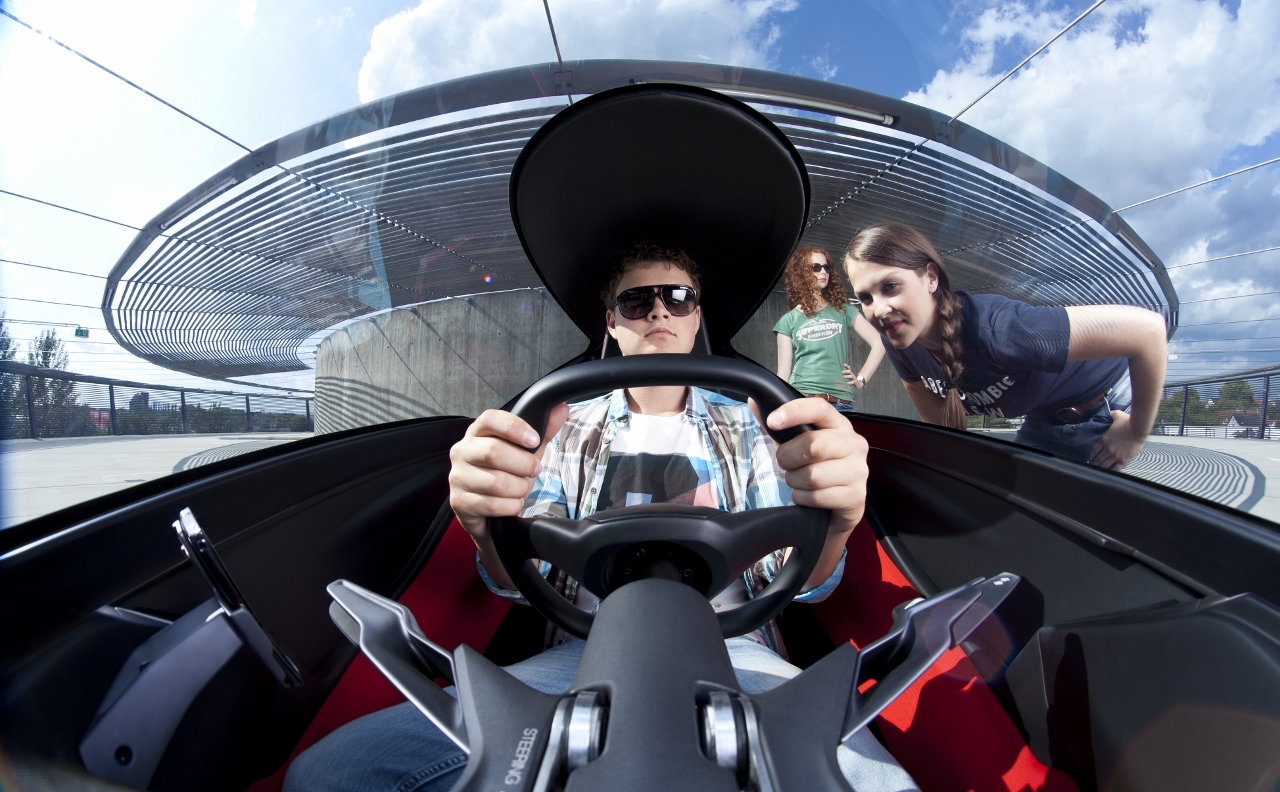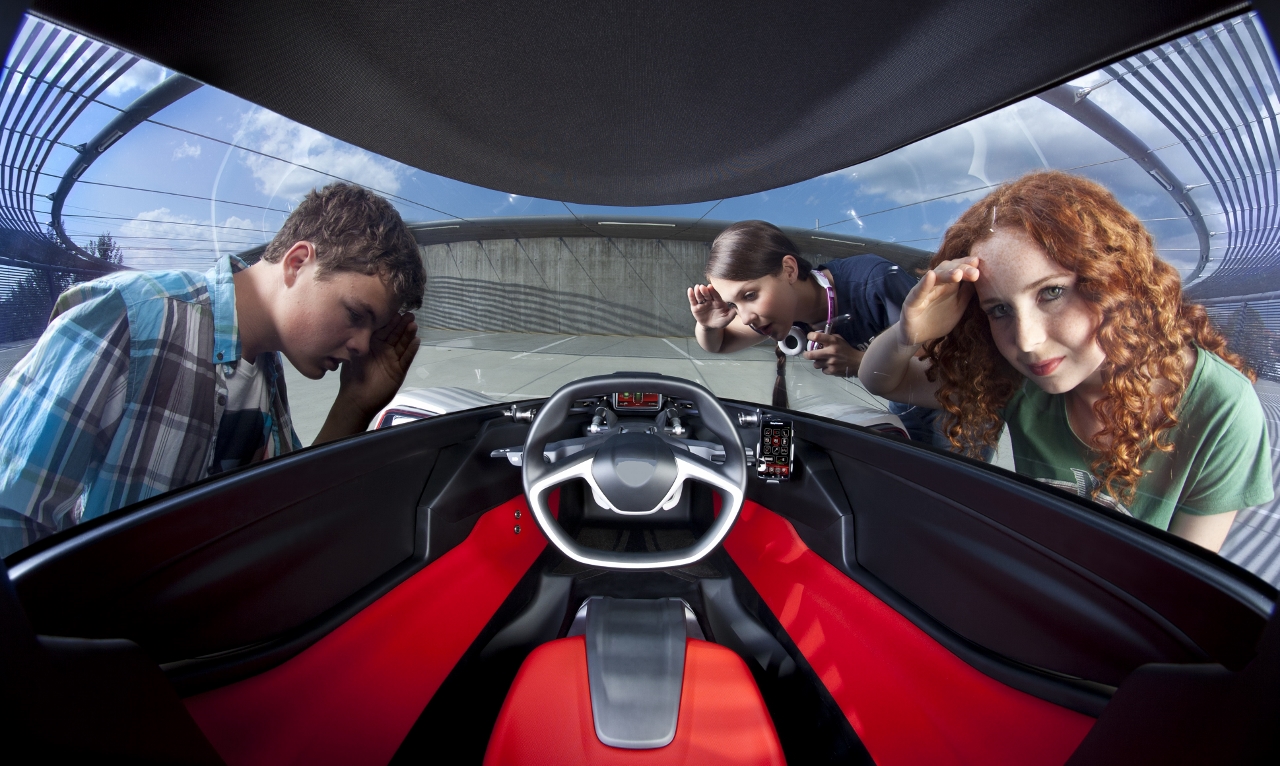is just 1.3 metres wide, around 3 metres long and 1.19 metres high.
The underlying structure is a steel space-frame structure combined
with a skin of conventional synthetic material. For its design,
KISKA and Vauxhall adopted a new approach, with both the interior
and the exterior designed in a single process, breaking down the
barriers between car and motorcycle design. The canopy combines the
functions of roof and windshield and gives a 270-degree view with
no blind spots. The steering wheel automatically swings out of the
way when the canopy is opened, and the hinge arrangement ensures
that the vehicle maintains its low profile. Although quad-cycle
rules make no safety stipulations, GM has imposed its own, for
side, rear and frontal impact, besides developing a Formula
One-style occupant restraint system. A single motorcycle-style
swing arm carries the rear wheels, whose transversely mounted rear
disc and calliper brake the single speed gearbox’s output shaft,
ingeniously saving weight. The front suspension is double
wishbone.
The Vauxhall RAK-e interior was designed as a tandem two-seat
commuter car concept, and is like an intriguing mix of car,
motorbike and jet-fighter. The large cockpit canopy gives the
driver and passenger a feeling of spaciousness and of course
all-around visibility. The front seat, steering column and armrests
automatically tip forward to enable easy-entry. On top remote
control via smart phone enhances the optical effect of this action.
The pedals and the steering wheel adjust to the size of the driver.
Although fully enclosed, in a similar arrangement like the Renault
Twizy, there is no air conditioning and in-cabin cooling achieved
by raising the canopy slightly, while seat heaters provide warmth
when needed. Instrumentation consists of a single screen providing
a speedo, eco gauge and battery range indicator, supplemented by a
smartphone that provides navigation and the means to control some
functions remotely while the car is charging, such as the seat
heaters. Style wise the interior is excitingly different, besides
the drama, and convenience, of that panoramic screen there’s the
novelty of the RAK-e’s narrowness, a go-kart-style pedal pairing so
that you left-foot brake, a dinky little squared off-wheel, a fixed
seat and adjustable pedals. And if you’re carrying one, a passenger
that sits in very close but not in uncomfortable proximity. To go,
you merely toggle the prototype rocker switch gear selector hidden
close to your right shin, press the accelerator and away you go. It
also goes quite slowly and steers rather lazily given its low
weight, but neither of these characteristics is remotely
representative of how the real thing would drive. But what the
RAK-e Concept does hint at, even when driving it in a very large
room, is just how much fun it would be to thread through traffic,
or to speed along tight, country lanes. Which is why GM has allowed
it a higher top speed than most baby commuter cars, its 75mph
maximum partly the product of the compact, low drag frontal area
afforded by its motorbike seating.
In an age where rocketing fuel prices and crowded city streets are
robbing the pleasure from driving, the Vauxhall RAK-e stands out as
a bright light. Imagine putting 62 miles for just £1 and doing it
in a sleek, jet aircraft inspired shape, being able to park
virtually anywhere and all with zero vehicle emissions. That’s the
reasoning behind the Vauxhall RAK e. The lithium ion technology of
the Vauxhall Ampera was the natural starting point to achieve this.
Officially, this narrow-tracked, canopy-roofed, electric city car
is an L7 category heavy quad-cycle, which means that it can weigh
up to 400kg, and offer up to 15kw of power. Its rear-mounted motor
produces 49bhp @ 6000rpm with torque of 43lb-ft from zero rpm and
can accelerate to 60mph in under 13 seconds, and onto 75mph. The
gearbox is a single speed automatic. So modest is its energy
consumption that it requires no more than a year’s worth of output
from five square metres of solar panels harvesting energy beneath
far-from-totally sunny UK skies to propel it 6200 miles. In other
words, it’s ultra-economical, costing under a pound to travel the
62 miles that also happens to be its nominal range, Which is 10% of
the cost of running a small hatchback.
You may think that this is exactly the kind of concept that you can
never buy but amazingly, Vauxhall is serious about this machine.
Technically the RAK-e is production ready, but says GM project
engineer Stefan Gloger the challenge is more about how and where it
is built. Figuring that out depends on how many Vauxhall & Opel
believe they can sell, and with a fresh concept like this, that’s
hard to calculate. But on the Vauxhall RAK-e’s side are a projected
price in the £8500-£11,500 range, and the discovery that everybody
of all ages liked the car when quizzed. A major plus is the
Vauxhall RAK-e’s sheer desirability, and never mind its ultra-low
running costs and zero local emissions. It also promises to be a
riot to drive. Vauxhall should be as bold with this as it has been
with the Ampera. The RAK-e is the electric commuter car made
exciting, and for the price of a Corsa then yes, why wouldn’t you
want to buy one, not only as a second or third commuter car, but as
a weekend entertainer besides? Insiders have said the car has been
put on hold. Let’s hope Vauxhall dares to illuminate it, for
rich-kids it could be made for even younger customers thanks to a
low-power mode with speed limited to 28mph for 16-year old
drivers!

